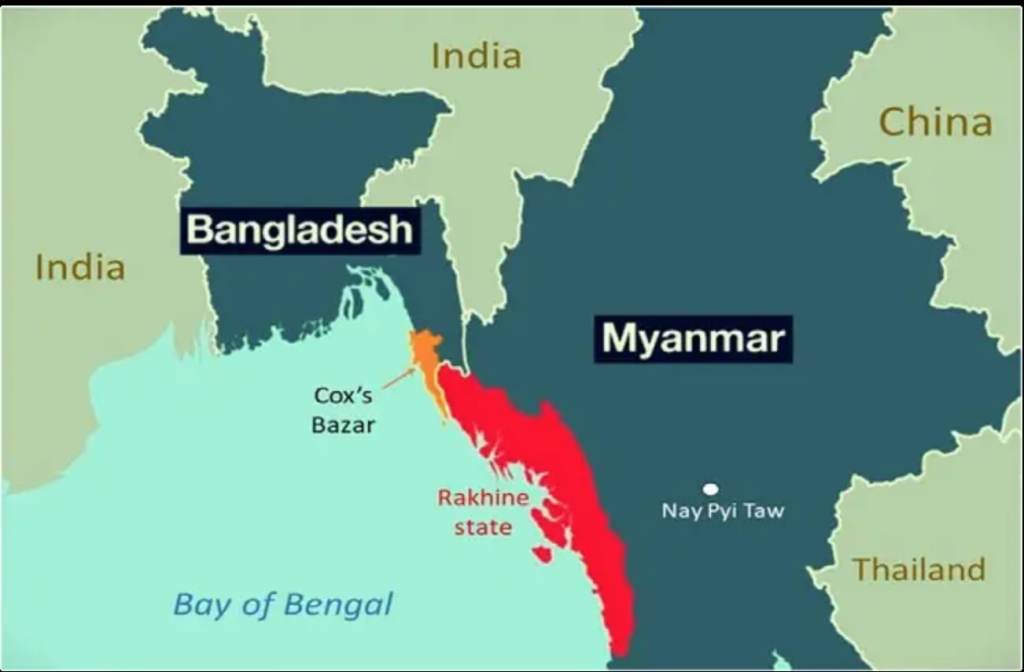The Rakhine (Arakan) Corridor has emerged as a contentious issue at the intersection of humanitarian need and geopolitical strategy. Once an abstract diplomatic concept, the Rakhine Corridor now has taken shape amid escalating violence, famine risks, geopolitical traps, and shifting power dynamics in Myanmar’s civil war. The importance of this corridor extends far beyond its physical location as it functions as a critical geopolitical fault line involving multiple actor and interests with competing agendas.

Figure 1: Myanmar’s conflict-ridden Rakhine state ; Source: News Arena Network
Origin of the Corridor Debate
The humanitarian corridor debate reignited in late 2024 when the Arakan Army seized control of most of the Myanmar- Bangladesh border, dramatically altering the security dynamics in the region. As the fighting raged between Arakan Army and remnants of the Myanmar military (Tatmadaw), thousands of civilians fled across the Naf River into southeastern Bangladesh, out of which most were Rohingya Muslims, but other minorities also joined the exodus, fearing persecution either from the junta, the AA, or local instability. By the end of 2024, the refugee camps in Cox’s Bazar were severely overcrowded, putting an immense pressure on Bangladesh’s infrastructure and humanitarian systems.
In early 2025- UN Secretary-General António Guterres visited Bangladesh between March 13 and 16, where he formally proposed the establishment of UN- administered humanitarian corridor – to lay future groundwork for safe and dignified Rohingya repatriation. The whole rational behind the proposal was to address the spiraling crisis in Rakhine, and establish a neutral humanitarian channel that is designed to bypass both military blockades and insurgent irregularities. However, this proposal quickly became politically and militarily fraught.
Interim Administration’s Mixed Signals
Bangladesh’s role in this scenario is torn between external pressure and internal priorities. While some members of the interim government have signaled willingness to this corridor if UN leads it, the country’s military and political opposition fears that such a corridor could erode Bangladesh’s sovereignty, especially when it is backed or influenced by western powers. As of July 2025, there is no formal corridor and the AA still holds full control over Myanmar’s side of the border with Bangladesh.
However, the analysis shows that the Bangladesh government has poorly coordinated this proposal marked by inconsistency, mixed messaging, and a lack of internal coordination, revealing divisions within the interim leadership. Initial signals from senior officials including National Security Adviser Dr. Khalilur Rahman , Foreign Adviser Touhid Hossain, suggested cautious openness prompted by international pressure after Guterres’ visit. However, this was quickly contradicted by other political factions (BNP, CPB, Jamaat-e-Islami, etc.) and the Army leadership. Also, at a press briefing in May 2025 , Dr. Khalilur Rahman issued a definitive statement and ruled out any possibility of allowing a “humanitarian corridor” through Bangladeshi territory into Myanmar. These series of conflicting announcements projects Bangladesh as reactive and divided, rather than strategically grounded and diplomatically disciplined.
Link to Northeast India
The proposed corridor present direct implication for India’s northeast, where connectivity and strategic security are tightly intertwined. Since the 2021 Myanmar coup, the rise of Arakan Army has deeply disrupted the Kaladan Multi-Modal Transit Transport Project (KMTTP) designed to connect Kolkata to Sittwe Port in Rakhine, and other regional transit projects. These disruptions are not merely technical but threatens to diminish the economic and strategic benefits envisioned for the Northeast.
If the internationally monitored corridor was to be formalized and sustainably managed in the future, it could enable India to complete the Kaladan project, revitalizing Northeast India’s trade, logistics, and broader connectivity with Southeast Asia and also could empowers non-state actors like the AA without long-term solutions, cross-border crime, arms trafficking, and refugee flows into Manipur and Mizoram.
All these potential benefits, risks and challenges places Bangladesh and Northeast India at a critical juncture, where the interplay of humanitarian needs, security imperatives, and geopolitical rivalries will shape regional stability and connectivity.
China’s Role
China’s role and investment in Rakhine State is deeply strategic, driven by a determination to protect its massive investments, secure its strategic access to the Indian Ocean, and retain influence over Myanmar.
China has poured billions of dollars into Rakhine, notably the Kyaukphyu Deep Sea Port, oil and gas pipelines, railways, and Special Economic Zones. These assets are critical for China’s Belt and Road Initiative (BRI), allowing China to bypass the Malacca Strait for energy imports and gain a direct trade route to the Bay of Bengal. China also maintains strong ties with both the Myanmar military and, increasingly, the Arakan Army (AA), which now controls much of Rakhine. This dual approach helps ensure the safety of its projects regardless of which faction holds territory.
The proposed corridor if formalized will have both negative impacts and potential benefits which might concern China. A corridor supervised by UN or US could definitely shift leverage away from China, putting key infrastructure within the operational orbits of western entities that may expose vulnerabilities in China’s infrastructure. Though , if the corridor is managed on China’s terms it may actually benefit from reduced chaos along its pipeline and transport routes.
Therefore, China will strictly control the nature, scope, and sponsors of any corridor in Rakhine that threatens its investments, energy lifelines, or strategic freedom of action.
Conclusion
Though there is no official or internationally supervised humanitarian corridor between Bangladesh and Myanmar, Bangladesh’s dual role as a refugee host and border manager places it at the epicenter of the Rakhine Corridor debate. At present the Arakan Army remains in complete control of Myanmar-Bangladesh frontier but failure to resolve Rakhine’s conflict risks refugee crisis, and great power rivalries. From Bangladesh perspective hosting large number of refugees while managing a volatile border demands a delicate balance. For China, the corridor threatens its strategic interests and for Northeast India, the corridor’s outcome directly impacts the Kaladan Multi-Modal Transit Transport Project. As the corridor region is already fragile, even under international administration the corridor is vulnerable to infiltration and manipulation by non-state actors, including ethnic armed organization and the Arakan Army.
Therefore, without coordinated efforts to secure humanitarian access and resolve the conflict, the corridor could remain a flashpoint, threatening the aspirations of Bangladesh, Northeast India, and the broader Indo-Pacific region.














